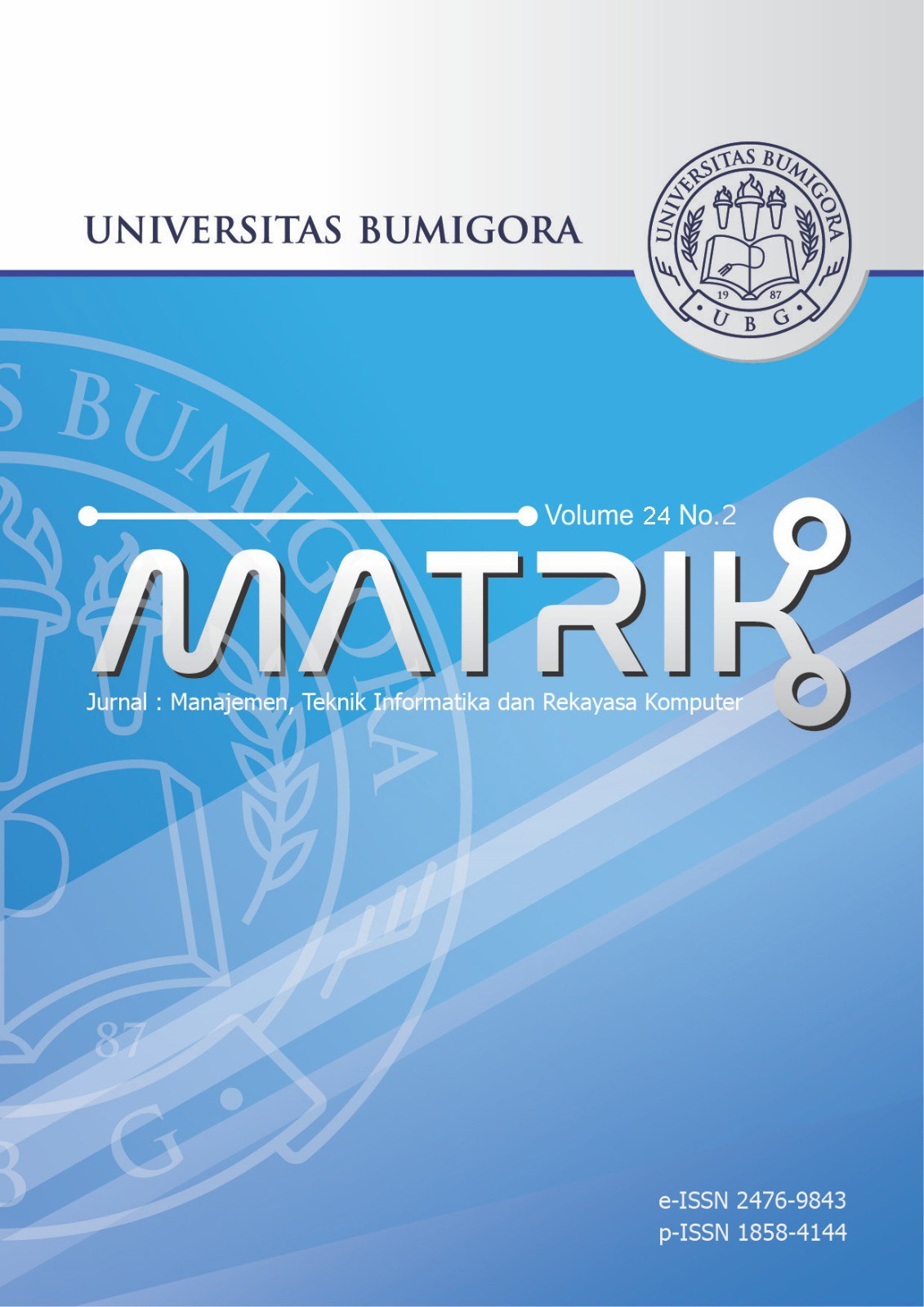Sentiment Study of ChatGPT on Twitter Data with Hybrid K-Means and LSTM
Analisis Sentimen Berdasarkan Hasil Klasterisasi K-Means pada Data Pengguna ChatGPT Menggunakan LSTM
DOI:
https://doi.org/10.30812/matrik.v24i2.4791Keywords:
Chat-Gpt, K-Means, Long Short-Term Memory, Sentiment Analysis, TF-IDF, Word2VecAbstract
The rapid evolution of artificial intelligence (AI) has transformed the way people interact with technology, with ChatGPT emerging as a standout innovation in natural language processing (NLP). While it offers immense benefits, such as improving productivity and accessibility, it has also sparked debates about trust, transparency, and user experience. This makes understanding public sentiment about ChatGPT both timely and essential.This study explores user sentiments by combining K-Means clustering and Long Short-Term Memory (LSTM) models for analysis. The research utilized a dataset from Kaggle, which underwent extensive preprocessing, including text cleaning, tokenization, and lemmatization. Key features were extracted using TF-IDF and Word2Vec techniques, while clustering was refined with the Elbow Method and Silhouette Score. The data was grouped into three clusters focusing on ChatGPT’s functions, its developers, and user activities. Sentiment analysis using LSTM achieved an impressive accuracy of 98% after five training cycles. The findings highlight that negative sentiments, particularly around technical challenges and transparency, dominate user feedback, signaling areas for improvement. While positive sentiments exist, they remain overshadowed by critical perspectives. This study underscores the importance of enhancing user trust and experience while ensuring ethical and transparent AI development. The insights provided aim to guide developers and policymakers in creating AI technologies that are more user-focused and socially responsible. Future research should include multilingual and cross-platform data to paint a more comprehensive picture.
Downloads
References
[2] F. M. Sinaga, S. J. Pipin, S. Winardi, K. M. Tarigan, and A. P. Brahmana, “Analyzing Sentiment with Self-Organizing Map and Long Short-Term Memory Algorithms,†Matrik: Jurnal Manajemen, Teknik Informatika dan Rekayasa Komputer, vol. 23, no. 1, 2024. DOI: 10.30812/matrik.v23i1.3332.
[3] Y. Akbar and T. Sugiharto, “Analisis Sentimen Pengguna Twitter di Indonesia Terhadap ChatGPT Menggunakan Algoritma C4.5 dan Naïve Bayes,†Jurnal Sains dan Teknologi, vol. 5, no. 1, pp. 115–122, 2023. DOI: 10.55338/saintek.v4i3.1368.
[4] D. Setiawan, D. Arsa, L. E. Fitri, and F. F. P. Zahardy, “Comparative Analysis of Clustering Approaches in Assessing ChatGPT User Behavior,†Cogito: Jurnal Penelitian dan Pengabdian Masyarakat, vol. 10, no. 2, pp. 366–379, 2024. DOI: 10.31154/cogito.v10i2.661.366-379.
[5] P. Yani and H. Baturohmah, “Analisis Sentimen Terhadap ChatGPT Plus Menggunakan Naïve Bayes di Twitter,†Sismatik: Jurnal Sistem Informasi dan Teknik Informatika, 2024. [Online]. Available: https://sismatik.nusaputra.ac.id/index.php/sismatik/article/view/210.
[6] I. Kurniasari, A. A. Alfin, and E. Widodo, “Implementasi Long Short-Term Memory (LSTM) dan Word Embedding Model pada Analisis Sentimen Layanan Uang Elektronik Ovo dan Link Aja,†Informasi: Jurnal Informatika dan Sistem Informasi, vol. 15, no. 2, 2023. DOI: 10.37424/informasi.v15i2.273.
[7] I. Dergaa, K. Chamari, P. Zmijewski, and H. B. Saad, “From human writing to artificial intelligence generated text: examining the prospects and potential threats of ChatGPT in academic writing,†Biology of Sport, 2023. DOI: 10.5114/biolsport.2023.125623.
[8] A. Nurkholis, D. Alita, and A. Munandar, “Comparison of Kernel Support Vector Machine Multi-Class in PPKM Sentiment Analysis on Twitter,†Jurnal RESTI (Rekayasa Sistem dan Teknologi Informasi), vol. 6, no. 2, pp. 227–233, 2022. DOI: 10.29207/resti.v6i2.3906.
[9] K. Maharana, S. Mondal, and B. Nemade, “A review: Data pre-processing and data augmentation techniques,†Global Transitions Proceedings, 2022. DOI: 10.1016/j.gltp.2022.04.020.
[10] R. R. Salam, M. F. Jamil, Y. Ibrahim, R. Rahmaddeni, S. Soni, and H. Herianto, “Sentiment Analysis of Cash Direct Assistance Distribution for Fuel Oil Using Support Vector Machine,†Jurnal Malcom, vol. 3, no. 1, 2023. DOI: 10.57152/malcom.v3i1.590.
[11] R. Sulthana, J. A. K., H. Harikrishnan, and V. Varadarajan, “Sentiment Analysis on Movie Reviews Dataset Using Support Vector Machines and Ensemble Learning,†International Journal of Information Technology and Web Engineering, vol. 17, no. 1, 2023. DOI: 10.4018/IJITWE.311428.
[12] F. Muftie, K. M. Yafi, and Q. M. Addina, “Perbandingan Performa Deteksi Cyberbullying dengan Transformer, Deep Learning, dan Machine Learning,†Jurnal Pendidikan Informatika dan Sains, vol. 13, no. 1, pp. 75–87, 2024. DOI: 10.31571/saintek.v13i1.4002.
[13] A. Sanmorino, Suryati, R. Gustrianysah, S. Puspasari, and N. Ariati, “Feature Extraction vs Fine-tuning for Cyber Intrusion
Detection Model,†Jurnal INFOTEL, vol. 16, no. 2, pp. 302–315, 2024. DOI: 10.20895/infotel.v16i2.996.
[14] A. Nurdin, B. A. S. Aji, A. Bustamin, and Z. Abidin, “Perbandingan Kinerja Word Embedding Word2Vec, GloVe, dan FastText pada Klasifikasi Teks,†Jurnal TEKNOKOMPAK, vol. 14, no. 2, pp. 74–79, 2020. DOI: 10.33365/jtk.v14i2.732.
[15] E. T. Wijaya, “Perancangan Information Retrieval (IR) Berbasis Term Frequency-Inverse Document Frequency (TF-IDF) untuk Peringkasan Teks Tugas Khusus Berbahasa Indonesia,†Jurnal Ilmiah Teknologi dan Informasi ASIA, vol. 7, no. 1, 2013. [Online]. Available: https://jurnal.stmikasia.ac.id/index.php/jitika/article/view/78.
[16] M. Guntara and N. Lutfi, “Cacah Klaster pada Klasterisasi dengan Algoritma K-Means Menggunakan Silhouette Coeficient
dan Elbow Method,†JuTI: Jurnal Teknologi Informasi, vol. 2, no. 1, Aug. 2023. DOI: 10.26798/juti.v2i1.944.
[17] A. T. Rahman, Wiranto, and R. Anggrainingsih, “Coal Trade Data Clusterung Using K-Means (Case Study PT. Global Bangkit Utama),†ITSMART: Jurnal Ilmiah Teknologi dan Informasi, vol. 6, no. 1, Jun. 2017. DOI: 10.20961/itsmart.v6i1.11296.
[18] M. Anggara, H. Sujiani, and H. Nasution, “Pemilihan Distance Measure Pada K-Means Clustering Untuk Pengelompokkan Member Di Alvaro Fitness,†Jurnal Teknik Informatika Universitas Tanjungpura (JUSTIN), 2023. [Online]. Available: https://jurnal.untan.ac.id/index.php/justin/article/view/13119.
[19] M. Robani and A. Widodo, “Algoritma K-Means Clustering Untuk Pengelompokan Ayat Al Quran Pada Terjemahan Bahasa Indonesia,†Jurnal Sistem Informasi Bisnis, vol. 6, no. 2, pp. 164–176, Dec. 2016. DOI: 10.21456/vol6iss2pp164- 176.
Downloads
Published
Issue
Section
How to Cite
Similar Articles
- Rahman Rahman, Teguh Iman Hermanto, Meriska Defriani, Hyperparamaters Fine Tuning for Bidirectional Long Short Term Memory on Food Delivery , MATRIK : Jurnal Manajemen, Teknik Informatika dan Rekayasa Komputer: Vol. 23 No. 1 (2023)
- Vivin Nur Aziza, Utami Dyah Syafitri, Anwar Fitrianto, Optimizing Currency Circulation Forecasts in Indonesia: A Hybrid Prophet- Long Short Term Memory Model with Hyperparameter Tuning , MATRIK : Jurnal Manajemen, Teknik Informatika dan Rekayasa Komputer: Vol. 24 No. 1 (2024)
- Frans Mikael Sinaga, Sio Jurnalis Pipin, Sunaryo Winardi, Karina Mannita Tarigan, Ananda Putra Brahmana, Analyzing Sentiment with Self-Organizing Map and Long Short-Term Memory Algorithms , MATRIK : Jurnal Manajemen, Teknik Informatika dan Rekayasa Komputer: Vol. 23 No. 1 (2023)
- Susandri Susandri, Ahmad Zamsuri, Nurliana Nasution, Yoyon Efendi, Hiba Basim Alwan, The Mitigating Overfitting in Sentiment Analysis Insights from CNN-LSTM Hybrid Models , MATRIK : Jurnal Manajemen, Teknik Informatika dan Rekayasa Komputer: Vol. 24 No. 2 (2025)
- Mukhlis Mukhlis, Puput Yuniar Maulidia, Achmad Mujib, Adi Muhajirin, Alpi Surya Perdana, Integration of Deep Learning and Autoregressive Models for Marine Data Prediction , MATRIK : Jurnal Manajemen, Teknik Informatika dan Rekayasa Komputer: Vol. 24 No. 1 (2024)
- Dwi Intan Af'idah, Dairoh Dairoh, Sharfina Febbi Handayani, Riszki Wijayatun Pratiwi, Susi Indah Sari, Sentimen Ulasan Destinasi Wisata Pulau Bali Menggunakan Bidirectional Long Short Term Memory , MATRIK : Jurnal Manajemen, Teknik Informatika dan Rekayasa Komputer: Vol. 21 No. 3 (2022)
- Helna Wardhana, I Made Yadi Dharma, Khairan Marzuki, Ibjan Syarif Hidayatullah, Implementation of Neural Machine Translation in Translating from Indonesian to Sasak Language , MATRIK : Jurnal Manajemen, Teknik Informatika dan Rekayasa Komputer: Vol. 23 No. 2 (2024)
- Ahmad Ashril Rizal, Siti Soraya, Multi Time Steps Prediction dengan Recurrent Neural Network Long Short Term Memory , MATRIK : Jurnal Manajemen, Teknik Informatika dan Rekayasa Komputer: Vol. 18 No. 1 (2018)
- Aini Suri Talita, Aristiawan Wiguna, Implementasi Algoritma Long Short-Term Memory (LSTM) Untuk Mendeteksi Ujaran Kebencian (Hate Speech) Pada Kasus Pilpres 2019 , MATRIK : Jurnal Manajemen, Teknik Informatika dan Rekayasa Komputer: Vol. 19 No. 1 (2019)
- Baiq Rima Mozarita Erdiani, Aryo Yudo Husodo, Ida Bagus Ketut Widiartha, Novel Application of K-Means Algorithm for Unique Sentiment Clustering in 2024 Korean Movie Reviews on TikTok Platform , MATRIK : Jurnal Manajemen, Teknik Informatika dan Rekayasa Komputer: Vol. 24 No. 2 (2025)
You may also start an advanced similarity search for this article.


.png)












